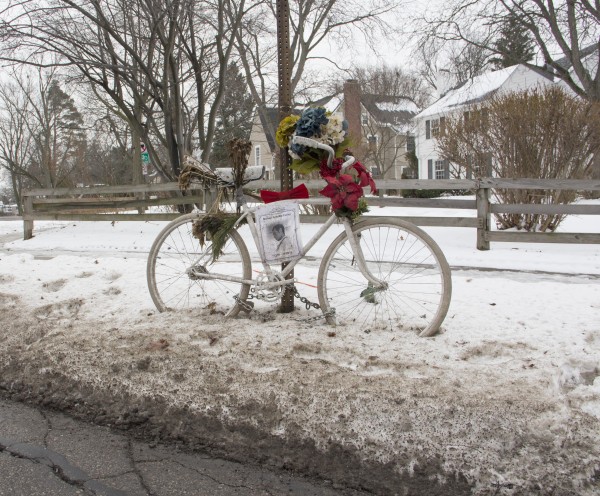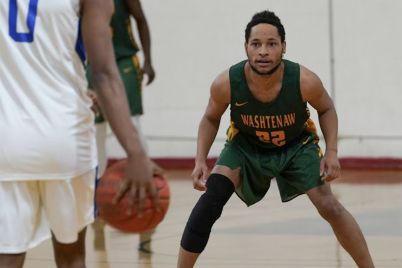
The ghost bicycle at the Washtenaw and Brockman intersection sits as a reminder of the loss of those due to biking accidents. GRAY BANCROFT | WASHTENAW VOICE
BY SOFIA LYNCH
Managing Editor
Over the past few months, a series of late-night biking accident fatalities in and around the city of Ann Arbor have brought pedestrian safety to the forefront of concerns for not only bikers, but community members as well. The city itself reacted to the local tragedies by allocating $1,000, through the City Council, to provide bike lights for Ann Arbor residents.
“We know when things like this happen at such a late hour, visibility may have something to do with it,” said Robert Kellar, communication specialist for public services for the city of Ann Arbor. “That’s the reason wearing protective gear and having your bike properly lighted is so important: so that people can see you.”
And visibility seemed to be the main issue with all of the recent high profile accidents, according to Ann Arbor Police Officer Doug Martelle of the community engagement division.
“The one on Washtenaw, the man had a headlight but didn’t have it with him. He had a rear light, and obviously he was still hit from behind… There was also a guy that was hit on south state near Textile, riding in the dark, early morning hours,” Martelle said. “Therein lies part of the problem: lighting.”
A Washtenaw Community College Electricity/Electronics Faculty member, and an avid biker himself, Dale Petty accounted for the fact that bike safety sometimes goes beyond the issue of visibility.
“I was hit one day in daylight with my bright yellow rain gear on and the person still didn’t see me,” Petty said. “Most drivers aren’t thinking about bikes or pedestrians, they’re thinking about other cars, so you’ve really got to get their attention somehow.”
While the city’s offer of safety lights shows a step in a positive direction for Ann Arbor, some WCC employees and bikers expressed that the issue with bicyclist’s vulnerability stems from the fact that the United States is behind in global standards of bike safety.
“If you compare us to other countries, we are way, way behind,” Petty said.
Andy Claydon, ITS Macintosh System Engineer for WCC, saw the disparity between the U.S. and other countries in the matters of bicycling education: “There isn’t real training out there. In some countries, at a certain age, in school they teach you how to ride a bike on the street.”
Claydon expressed that picking the right route and being on the right roads are key to safe biking.
Ingrid Ankerson, a WCC design instructor and sustainability council transportation group facilitator, shared her advice on how to practice safe biking.
“I think as a biker you have to be so defensive and have to, even during the day, have your headlights on, wear bright clothes, and just kind of be in traffic and assume that people don’t see you,” Ankerson advised.
For those Ann Arbor residents interested in heeding her advice or just acquiring a bike light from the city, email walkbikedrive@a2gov.org and provide all relevant contact information, so someone from the city can reach back out to them, according to Kellar.


